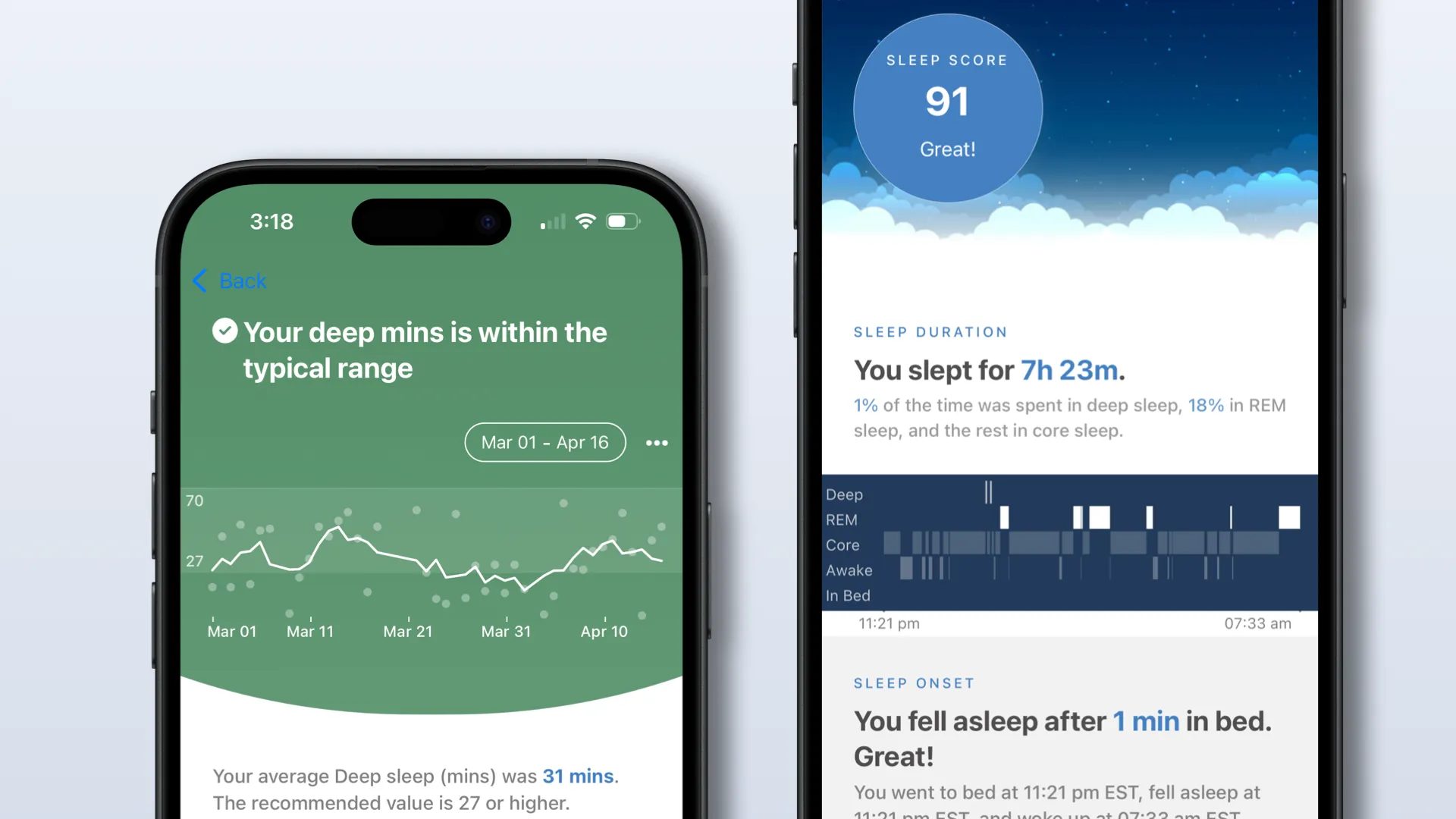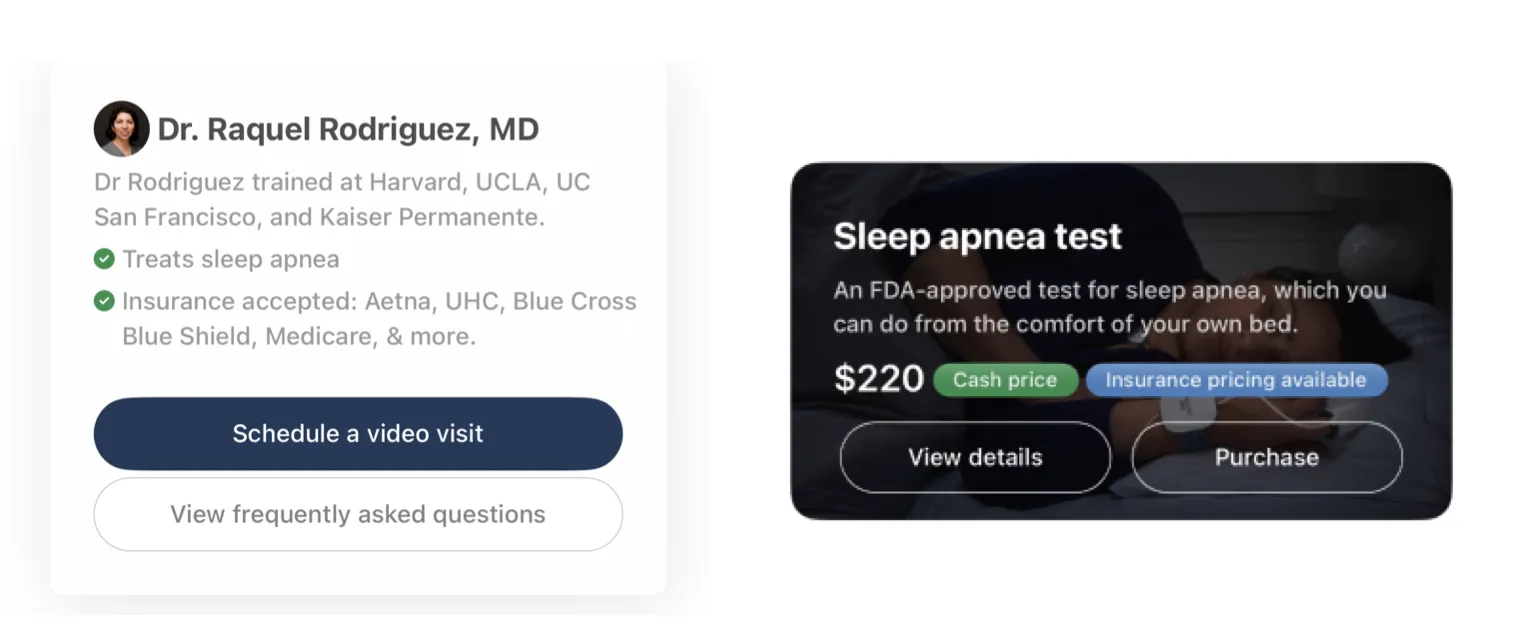Updated for watchOS 26 and Apple Watch Series 11 as of Oct 2025.
One of Apple Watch’s most exciting features is sleep stages, where each night’s sleep is categorized into core, deep, and REM. After squinting at their raw data, everybody has the same question: is my data normal? How much do normal core, deep, and REM sleep vary from person to person?
This post explains some of the science behind sleep stages—including the purpose of each stage—and provides some helpful benchmarks of the average, 10th percentile, and 90th percentile of both deep and REM sleep, based on data from Empirical Sleep and Empirical Health for Apple Watch.
 Data in this post is powered by Empirical Health for Apple Watch
Data in this post is powered by Empirical Health for Apple Watch
The science behind sleep stages
Apple Watch divides your sleep into three categories: core, deep, and REM.
Those categories are based on the well-known sleep cycle, where each night’s sleep is divided into cycles which last about 90 minutes, and each cycle has four stages.
-
Core or light sleep make up the first two stages of each cycle. While they make up the majority of the time, they’re the least restful.
-
Deep sleep , or slow-wave sleep, is the third stage and is critical to restorative sleep—deep sleep is when your body repairs muscles and your immune system.
-
REM sleep is the last stage, is typically when you dream and is believed to be important for memory, learning, and creativity. Early in the night, you tend to spend more time in deep sleep and later in the night you spend more time in REM.

Your sleep is divided into cycles throughout the night, N1, N2, N3, and REM. N1 and N2 correspond to Core sleep and N3 corresponds to deep sleep on Apple Watch. REM is REM. Source: Sleep Foundation.
How are sleep stages measured in the lab? How does Apple Watch do it?
The gold standard to measure sleep stages in a lab is an EEG (electroencephalogram), a device worn on your head which detects brain waves. Apple Watch creates an approximation based on its accelerometer, heart rate sensor, and blood oxygen sensor. This approximation can’t easily distinguish between N1 and N2, so those are combined into Core sleep.
How much deep sleep is normal?
The average Apple Watch user gets 49 mins of deep sleep per night —about 13% of total sleep time. (If you did the math and calculated the average person gets about 6.5 hours of sleep, that’s right—most people aren’t getting enough sleep.)
13% is the average, but there’s a lot of variance. If you spend 18% of your total sleep time in deep sleep, that puts you in the top 10% of sleepers (congratulations!). Conversely, if only 7% of your sleep time is deep sleep, that puts you in the bottom 10% of deep sleepers (for some common causes, see later in this article).
How much REM sleep is normal?
What about REM? The average Apple Watch user spends 20% of their time in REM sleep. Most people—4 of 5 people—spend between 15 and 25% of their time in REM.
Sleep apnea and low deep or REM sleep
Low deep sleep may be caused by sleep apnea, a health condition where your breathing stops during sleep. The latest Apple Watches may alert you to possible sleep apnea, but they don’t actually diagnose it.
To get a diagnosis, you need to complete an at-home, FDA-cleared sleep apnea test (photo below). You can complete the test overnight in your own bed. At-home sleep apnea tests are often covered by insurance when ordered bdy a doctor.
 An at-home sleep apnea test. Empirical Health doctors treats sleep apnea in 30+ US states.
An at-home sleep apnea test. Empirical Health doctors treats sleep apnea in 30+ US states.
What is core sleep? And how much is normal?
Core sleep is all sleep that’s not REM or Deep Sleep. While core sleep is the majority of sleep time (67% on average), it’s the least restorative. That means there’s no normal amount of core sleep. It’s better to instead focus on getting enough deep or REM sleep.
My REM or deep sleep is below average. What could be the cause?
Many factors drive sleep quality, ranging from medical conditions to your daily habits. Here are the most common factors that lead to insufficient deep or REM sleep:
-
Sleep disorders : sleep apnea, narcolepsy, and restless leg syndrome can disrupt the normal sleep cycle and prevent a person from getting enough deep and REM sleep. In our analysis of Empirical Sleep data, sleep apnea was the #1 factor driving reduced sleep quality. Some Apple Watch models now detect signs of sleep apnea.
-
Neurological conditions like Parkinson’s disease and Alzheimer’s disease can reduce REM and deep sleep.
-
Medications: certain medications, including antidepressants, antihistamines, and some blood pressure medications, may interfere with deep and REM sleep. (In Sep 2025, high blood pressure notifications launched as part of watchOS 26.)
-
Substance use: alcohol, caffeine, and nicotine can disrupt sleep, especially when used near bedtime. In our analyses, using alcohol or caffeine within 4 hours of bedtime use was the #2 factor driving reduced sleep quality.
-
Stress and anxiety: high levels of stress and anxiety can make it difficult to fall asleep and stay asleep.
-
Aging: As we age, the amount of deep and REM sleep we get naturally decreases, and this can contribute to sleep disturbances and reduced sleep quality.
-
Sleep hygiene, irregular sleep patterns, and inconsistent bedtimes can reduce sleep quality by creating tension between your sleep schedule and your natural circadian rhythm.
Get your own personalized data with Empirical Health
Want to know how your deep or REM sleep measures up? The metrics screen in Empirical Health is designed to help you benchmark your sleep data, including not just sleep stages, but also sleep duration, onset time, quality, sleeping oxygen, heart rate, and more.
It also helps you identify the causes behind poor sleep—for example, by assessing your risk of sleep apnea or sleep hygiene level using standardized medical surveys.
Download Empirical Health on the App Store here: https://apps.apple.com/us/app/empirical-health-for-watch/id6449271489?ppid=00f2fe74-f67f-4405-9616-3056b3dc1ed2
Get your free 30-day heart health guide
Evidence-based steps to optimize your heart health.

